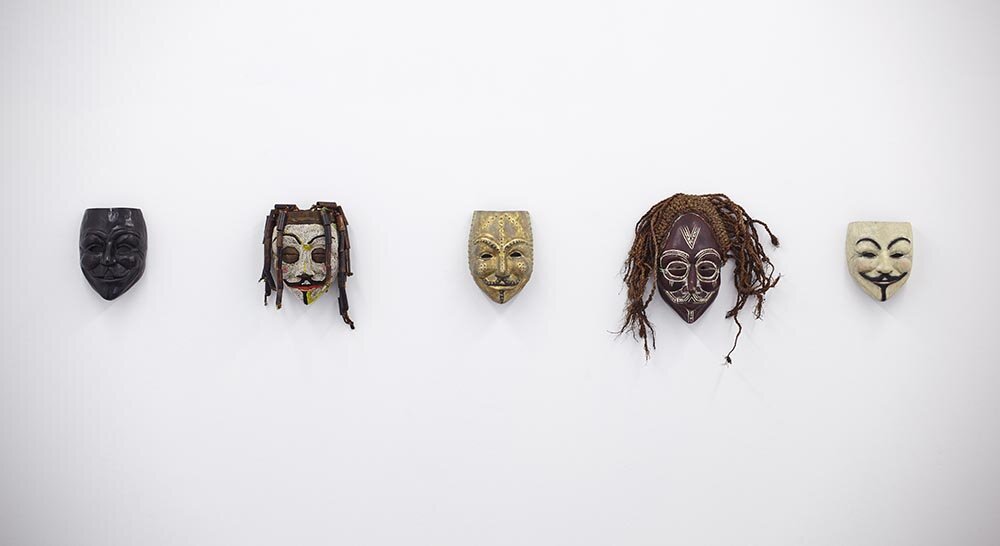Armory Show 2016: WHATIFTHEWORLD
Dan Halter
The Armory Show/ Focus: African Perspectives demonstrated that South Africa, and especially Cape Town, is the site of a dynamic international art scene. The multi-racial/-ethic/-generational converged onto a section of Pier 94. The work — political, reflective and introspective — took the form of maps, masks, archives and appropriations. These pieces sorted through time and space while looking at the country’s troubled history as it keeps up with a rapidly changing environment.
Part 1: WHATIFTHEWORLD, Cape Town
Dan Halter
Patterns of Migration, 2015
Mannequin legs, custom-made tartan fabric, found plastic-weave bags and Adidas ZX Flux Clot
236 x 71 x 71 cm
Image courtesy of Dan Halter and WHATIFTHEWORLD
Dan Halter’s large anthropomorphic sculpture constructed from Chinese shopping bags, a symbol of the movement of people and goods across borders. These bags were the vessels for those who needed to pack and move quickly. Though these bags can be bought for one dollar by the US consumer and are considered disposable as soon as a handle breaks, in other parts of the world, to people living in poverty, these bags aren’t disposable – they are used and re-used. These bags served as luggage for migrants — often called “Third World Louis Vuitton.” The bags cross borders to transport goods for sale and for importation/exportation. Halter explored the bags’ history as he traded them with peoples coming in from inside Africa by the border between Zimbabwe and South Africa and people coming in from the train. Often they would bring in these bags coming with items to and from the markets. This led to conversations and negotiations as the artist noticed the repairs on the bags whether they were stitched by the previous or current owners.
Dan Halter
Rifugiato Mappa del Mondo, 2011
New and found plastic weave bags
Approx, 183 x 380 cm
Image courtesy of Dan Halter and WHATIFTHEWORLD
A map projection constructed from Chinese plastic-woven shopping bags — in varying states of use and repair — was stitched together to illustrate a world in which globalism creates regions of great wealth juxtaposed with harsh poverty. The map shows, through the use of worn and new pieces of these shopping bags, areas from which migrants emigrate. The newer pieces of the bags are used to create the wealthier regions that serve as migrant destinations.
Dan Halter
One Dollar, 2011
Farming region map of Zimbabwe woven with 300 trillion dollars worth of Zimbabwe currency the equivalent to 1 USD at the height of Zimbabwean hyper inflation.
82 x 89 cm
Image courtesy of Dan Halter and WHATIFTHEWORLD
Dan Halter
One Dollar, 2011 (Detail)
Farming region map of Zimbabwe woven with 300 trillion dollars worth of Zimbabwe currency the equivalent to 1 USD at the height of Zimbabwean hyper inflation.
82 x 89 cm
Image courtesy of Dan Halter and WHATIFTHEWORLD
Halter confronts his own migration story more directly in a map of his homeland, Zimbabwe, made from shredded and woven currency, illustrating Mugabe’s land redistribution campaign. The use of shredded currency emphasized the resulting hyperinflation, a by-product of the post-colonial government’s corruption. It shows an example of how good ideas in revolutionary theory can easily become corrupted with disastrous results in practice.
300 trillion Zimbabwe dollars represents the amount of Zimbabwe Dollars required to buy one US Dollar on the black market at the height of inflation in February 2009. The shredded bank notes in this work are Z$50 Billion Zimbabwean Special Agro (Agricultural) cheques. This currency was initially only intended for farmers, but found its way into regular use because of the parallel functions with bearer cheques and exponentially rising food prices.
Matthew Bradley, Director, WHATIFTHEWORLD
Dan Halter
V for Vendetta, 2015
African masks and mutidimensions variable
Image courtesy of Dan Halter and WHATIFTHEWORLD
Another wall displays a row of masks, which at first glance, appears as a cliché of the wall of a Western African art collector. As I took a closer look, I found that the masks were all versions Guy Fawkes masks constructed in the style of various cultures and regions on the continent. The display subverts the practice of westerners collecting pieces of non-western culture, questioning the African art collector’s misconception African cultures as monolithic, primitive, and frozen in time. The masks also critique the consumption of cultural artifacts and their changing means of production – from the ceremonial to the pieces that are solely produced for the consumption of tourists and collectors. These masks have been infused with new power and meaning by means of the appropriation of Western revolutionary iconography.















